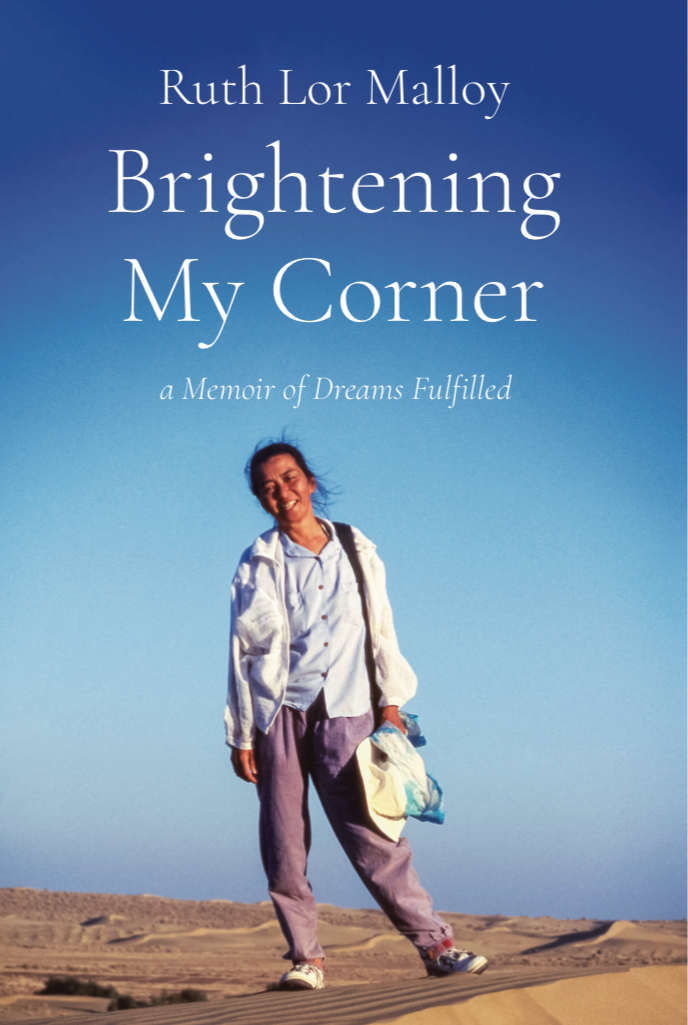
Copyright © Ruth Lor Malloy. All Rights Reserved
Available from Amazon,
Barclay Press, Barnes & Noble, and in Canada, Indigo-Chapters, Book City & York University Bookstore.
Ruth Lor Malloy
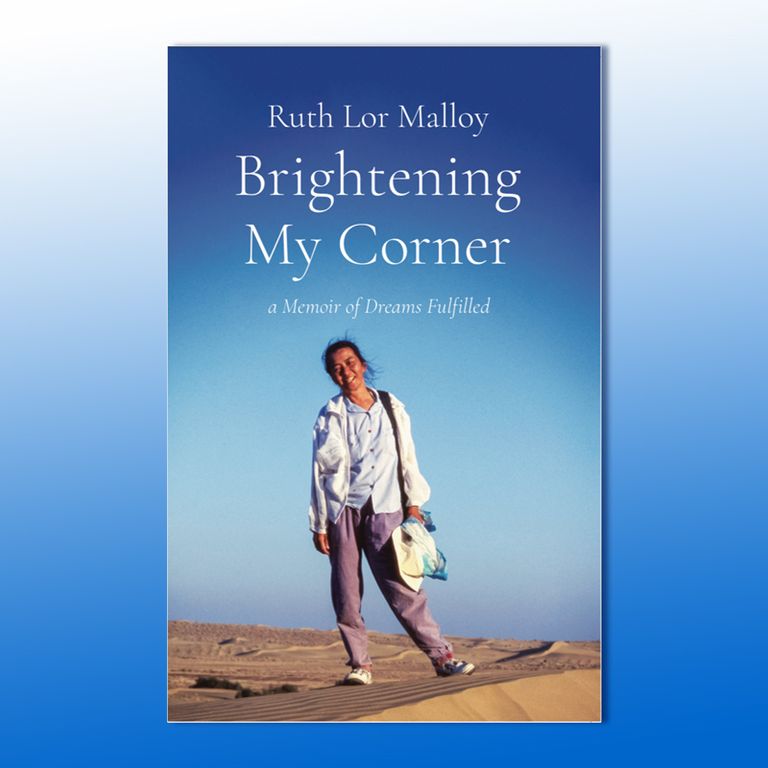
Praise for
Brightening My Corner
Pre-publication reviews about Brightening My Corner: a Memoir of Dreams Fulfilled.
“... No book has made me tip in a spiritual direction quite this obviously or unexpectedly. It is a story of a life well-lived that struck me and stays with me as I teach, parent, relate and carry out my own adventures in a complicated world...” Aaron Haddad. teacher and playwright.
-- “... It is a fascinating tale of adventures spanning continents and decades, covering history as it was made, seen through the eyes of a curious, thoughtful Canadian... ” Sonali Verma, journalist.
ABOUT
My dream now is for everyone to work together for the good of all so we can save our world. Can this one be fulfilled?
Ruth Lor was born in Canada in 1932 and grew up in a post World War Two era not too long ago. Like many people today, she wanted to make the world a better place, but the problems were too big. That didn't deter her from trying. Brightening My Corner is about that attempt. It is an adventure and a love story.
She hopes her story will inspire others to make an effort too. The key is seeing one's fellow human beings as friends and not as enemies. Changes start with brightening one's own corner.
Ruth was just an ordinary small-town high school girl who wanted to be a foreign correspondent. This dream combined her love of travel, writing and learning, but she was a victim of racial discrimination. Her family had come from China. Children in her town were mainly white-skinned. They shouted hurtful names and rhymes at her on the street and boys never showed any interest in dating her. These made her feel inferior and she brooded about who and what she was.
Her father had been among the lucky ones who had arrived in Canada before its 1923 Chinese Exclusion Act and he had found a Chinese wife in Canada. Their relatives were mainly males from the same village in China. A Christmas photograph, taken in the Lor family cafe, clearly shows the disproportion of single men and men with families. You can see Ruth there too, far right at back, near her father and mother.
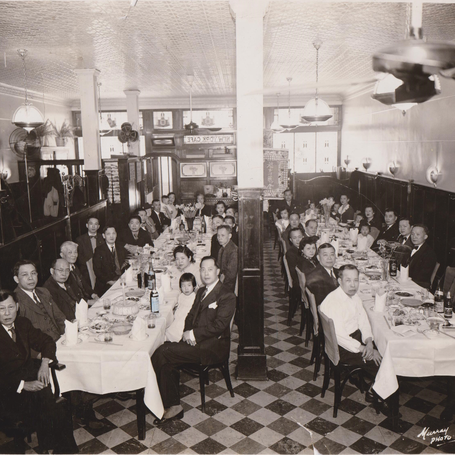
Eastern Ontario Chinese community Christmas party, New York Cafe. Ruth is across from mother far right back. 1946. Lor Family Collection.
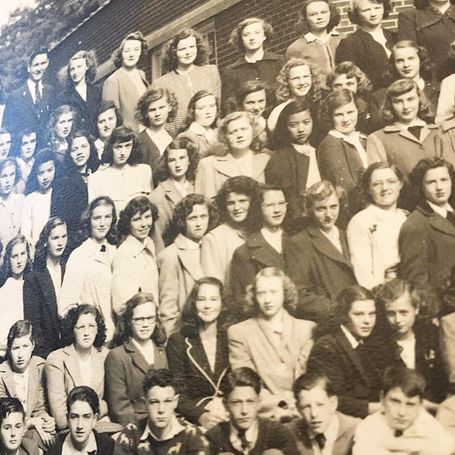
Sisters Alice and Ruth in Brockville Collegiate photo, third row from top. Alice was 18 months older and became a nurse. LFC.
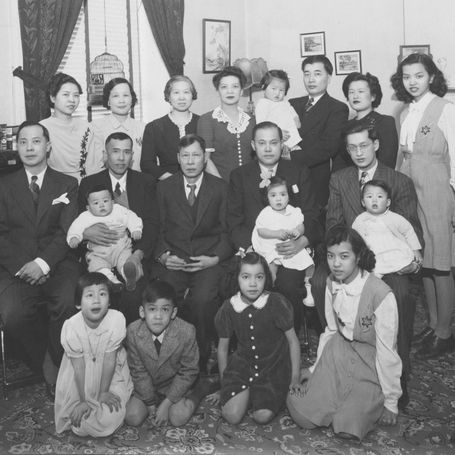
With close relatives. Ruth is front right beside siblings Valerie and Joe. Mother with lace collar in back row. Alice standing back row right. Father holds Gloria. 1946. LFC.
During the late 1940s one of her high school teachers told her that people of Chinese origin were not allowed to be journalists, but that didn't stop her. She managed to convince her parents to let her go to college instead of helping with the family restaurant. Meeting foreign students, studying, and the Student Christian Movement broadened her world. She discovered that she wasn't the only victim of ignorance, nor was she free of racial or cultural prejudices herself. She wondered what could be done about it.
After she graduating from college, Ruth attended a workshop in Washington, D.C. on non-violent ways to combat racial inequality. Maybe that was a solution, she reasoned. There she learned about testing new anti-racist laws in playgrounds and soda fountains. It was 1954, a year before a black woman in Alabama named Rosa Parks was arrested for refusing to give up her seat in a public bus for a White man.
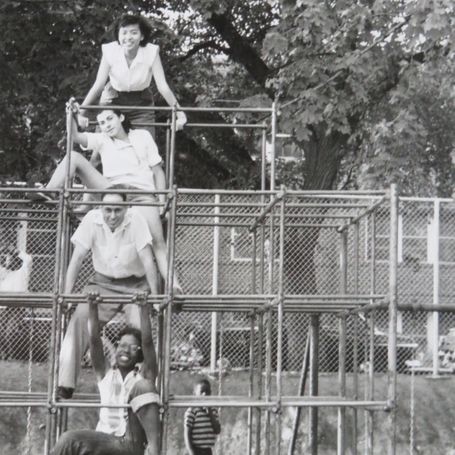
Ruth at a workshop testing for racial discrimination against Black people in a Washington, D.C. playground. That's her on top. 1954.
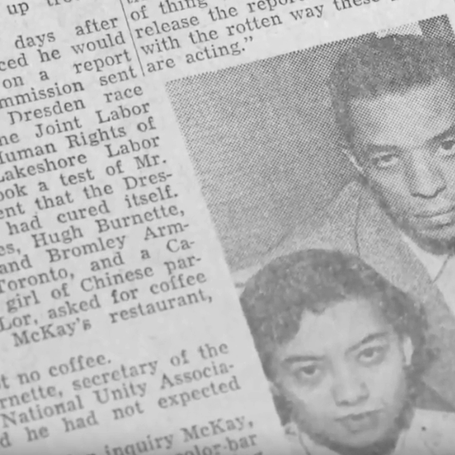
With Bromley Armstrong in Fair Accommodations Practices Act test case. Front page. Toronto Telegram. 1954.
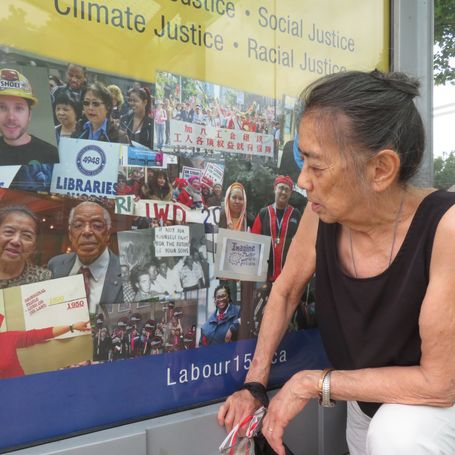
Ruth discovers photo of Bromley and her in Labour Council poster at a Toronto bus shelter almost 70 years later. 2021.
Back in Toronto, a labor union official invited Ruth to take part in a test case of a new anti-racial discrimination law in Ontario. The testing group proved in court that a merchant in an Ontario town had refused to serve Black customers. With that success, Ruth found herself and other team members in text books, videos and public posters. She had become a part of Black History.
In 1947, people of Chinese ancestry were allowed to vote in Canada. All citizens of Canada could sponsor spouses and children to join them in the country. When an uncle asked her to work on a petition to expand the law to include grandparents, she started to work with other Chinese-Canadians to make a change.
A few years later the government altered laws regarding Asian immigration and she felt another empowering moment. People like herself, working together, could help to make changes.
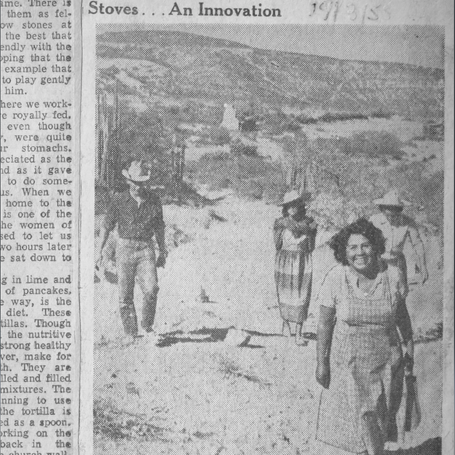
Government worker leads volunteers to build stoves in Mexican village while Ruth takes the picture for her hometown paper. It was the beginning of her multifaceted career. 1955.
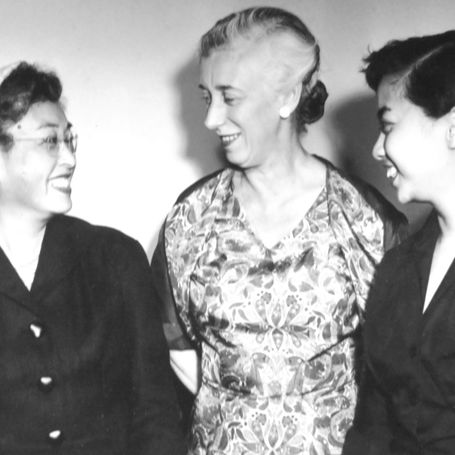
With Minister of Immigration, Ellen Fairclough (center) and Muriel Kitagawa (left). Japanese and Chinese-Canadian delegations in Ottawa. June, 1958. © Library and Archives Canada. Reproduced with permission.
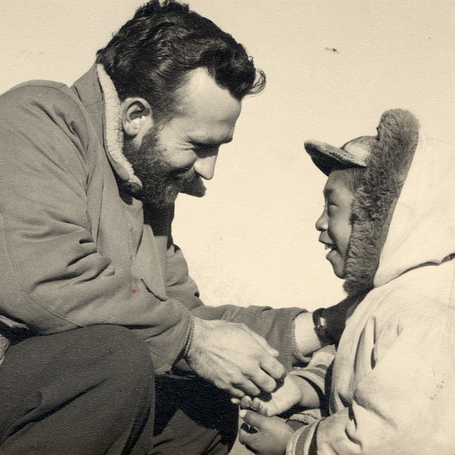
Ruth’s Arctic workcamp group in Iqaluit helped develop a rehab centre for Inuit survivors of tuberculosis. The volunteers included Jack Snell (left) seen here making friends with Pauloosie. 1957.
Then Ruth felt compelled to go to Mexico as a volunteer at a Quaker workcamp to help raise living standards in an Indigenous village. Her Brockville newspaper asked for reports and photos for which it paid $5 an article. There she worked as a mason and planted trees. Later, back in Canada, she organized a group of Canadian volunteers to prepare a government rehabilitation centre for Inuit survivors of tuberculosis in the Canadian Arctic. This project prompted a Toronto newspaper to ask her to write articles about their adventures there. Volunteering as a house painter was helping her evolve into a freelance writer and photographer.
Inspired by her adventures and financed by savings from various related jobs, she embarked on a six-month trip to Asia in 1960. That trip lasted about three years. It included a workcamp in Japan that brought together Japanese and Hong Kong high schoolers, only 15 years after the Japanese invaders had been forced out of Hong Kong. She wondered why the delightful, polite, hospitable Japanese committed such atrocities in China in the 1930s and 1940s. In Taiwan, she found hatred and fear separating the local-born Chinese and the mainlanders who had fled there after the Chinese Communists had defeated them. She was able to cover expenses by writing and photographing. She also acquired a writing job with a U.S. charity distributing food to the poor. Then came an offer to work for almost two years as an expenses-paid volunteer based in India with the Quaker International Seminars program which brought together individual Russians and Americans, Indians and Pakistanis, Japanese and Singaporeans, etc. As always, she was happy to try to reconcile groups of people with conflicting national and cultural issues.
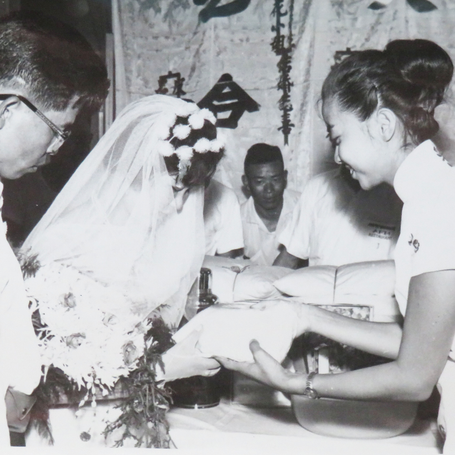
In Taiwan, her writing job was
with a NGO distributing food to the poor. It included giving gifts to newly-wed couples in a mass wedding.
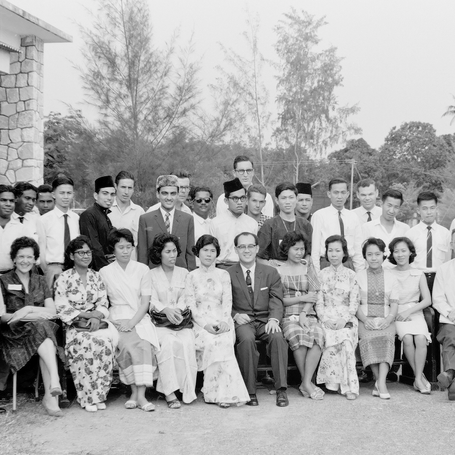
In Malaya, she attended a seminar trying to reconcile differences between conflicting cultural groups. This led to more work with Quakers. 1961.
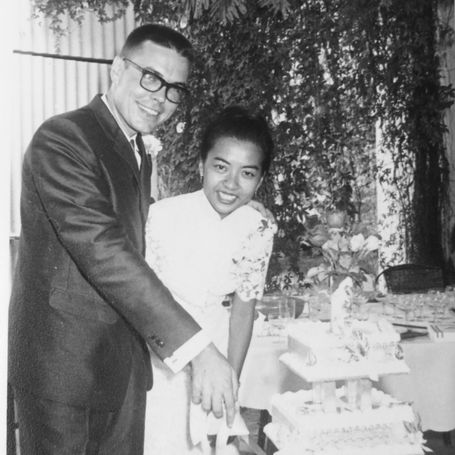
Ruth considers her acceptance of Michael Malloy’s proposal to be the best decision she ever made. They wed in Hong Kong after her first trip to China.
Then one Sunday in India, after a Quaker meeting for worship, an American woman invited her home to meet her son who was a foreign correspondent. Their first date included stampeding elephants, baton-wielding policemen, and a dead holy man. Two years later, she lucked into a hard-to-obtain visa to China and after emerging from that country, started writing about the new China.
Michael Malloy and Ruth were married in Hong Kong. They lived together in wartime Vietnam where he was bureau chief for United Press International. As a freelancer, she could finally call herself a genuine foreign correspondent able to hitch rides on U.S. military helicopters and write stories for American newspapers. But she didn't want to write about the fighting. She was against the war.
For half a century after that, Mike and Ruth continued to explore the world separately or together. His job in financial journalism meant moving the family to the U.S., the Philippines, Hong Kong and Canada. At times, it was very challenging for him. Once he had to swim a river and climb a mountain to interview Indigenous leaders in a Filipino village. His story led to the cancellation of a dam that would have forced those long-time inhabitants to move from their ancestral lands.
And then there was the time when the government threatened to arrest him. Ruth had to advise their children what to do if the police came and took away their father.
With Mike's encouragment, Ruth spent about 35 years researching and writing guide books to help English-speakers travel in China try to get around and understand that vast country. The couple worked together bringing up their children. It wasn't always easy.
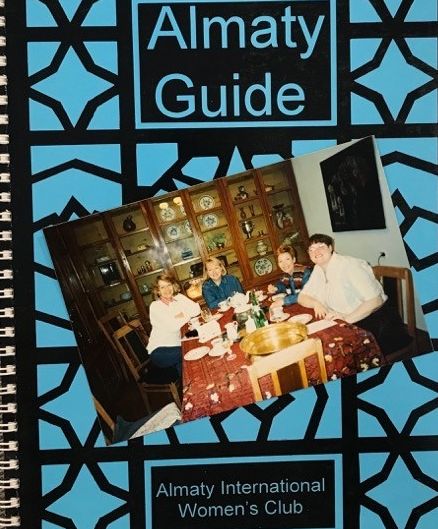
Ruth worked with friends to produce this guide book for English-speakers about services in Almaty, Kazakhstan. 1996. Photo credit Nancy Swing.com.
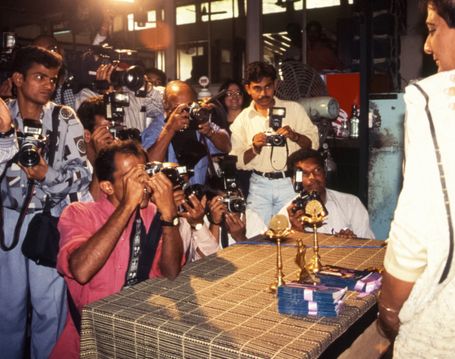
In Mumbai, India she helped write a book about a group of prostitutes and beggars. She likes to think its launch at the Bombay Press Club changed a lot of hateful attitudes.
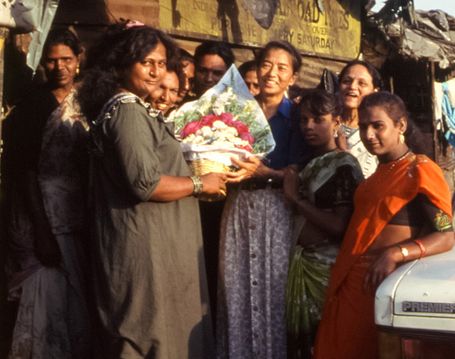
At their parting, Hijra friends gave Ruth flowers and messages of appreciation. The feeling was mutual. Getting to know these misunderstood people was one of the highlights of her life. 1997.
And so it went. Opportunities to help and learn were everywhere. When Mike's retirement took them to Kazakhstan, she collaborated with new friends on a guide to advise English-speaking foreigners on how to shop and bank in that Russian and Kazakh-speaking country. This helped both newcomers and locals.
Later in India curiosity drew her to a despised group of transgendered beggars and prostitutes. Helping Hijras gain some respect was not easy either, but working together with them was another satisfying project. Back in Toronto, she joined a Quaker committee to help resettle refugee families. For ten years, she wrote a blog on events in multicultural Toronto aimed at encouraging a feeling of community in her culturally-diverse city.
But you don't have to be a writer to help people. There are other ways. She was also a field collector, a tour guide, a wife and mother.
She hopes her memoir will spark others to make an effort to do more about violence, famine, global warming and epidemics instead of just pleasuring themselves. Urging governments and supporting groups who are also trying to solve these problems can help, but humans have to start with healing ourselves of hatred, greed, resentment and ignorance. She believes that by respecting the rights of others as well as ourselves that we can find real peace and contentment. Hers is a message first heard many centuries ago.
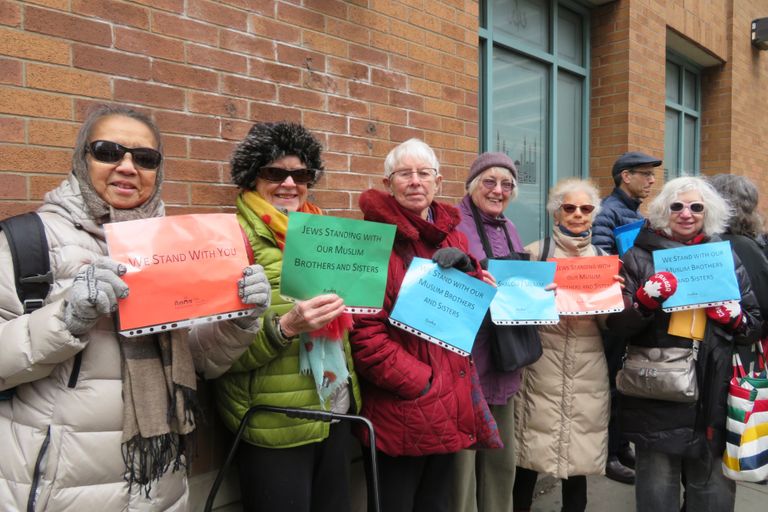
Ring of Peace with friends protecting Masjid Toronto after a gunman killed six people in a mosque in Quebec. A Toronto church and synagogue organized the event. 2017.
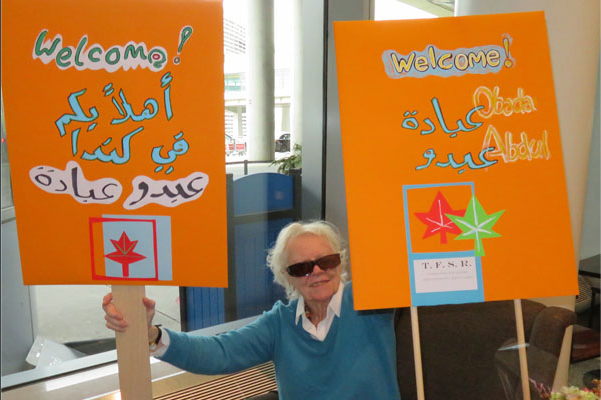
Ruth worked with a Quaker committee to help three refugee families settle in Canada. Ann Buttrick painted a welcoming sign for one group arriving at Toronto airport.
Travel Writer, Journalist, Author:
Ruth tried to use her writing and photography to build bridges of understanding between cultures. Her dozen or so guide books on China sold thousands of copies. None of these are available now as they are out of date.
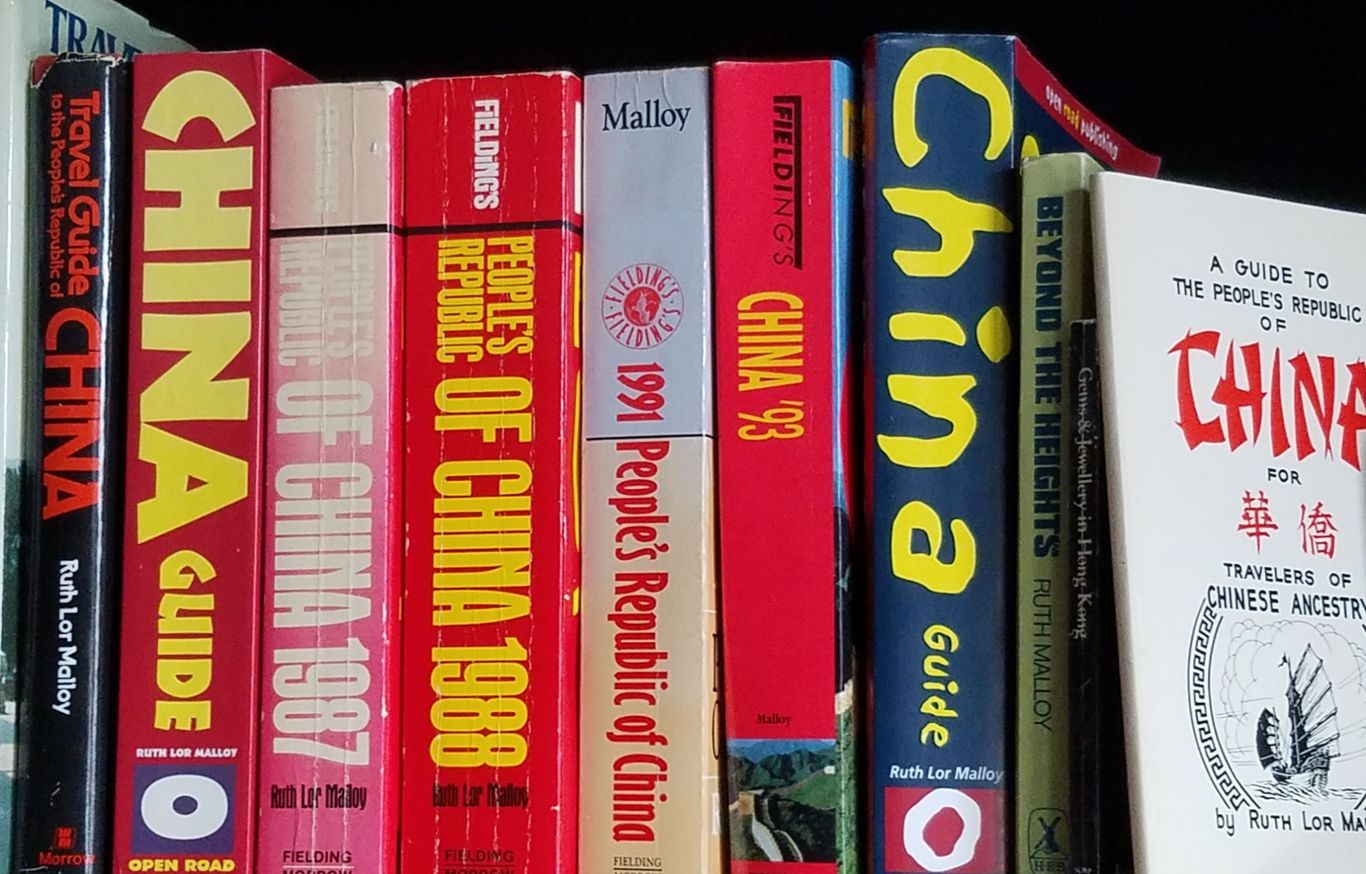
She thinks that adventurers who want to follow a travel, writing and volunteering path today still have opportunities to finance their trips. Volunteer jobs are available for those who have useful skills like nursing, teaching English or computers. Writing opportunities are no longer abundant and can be more dangerous. Learning about life from new friends around the world can be its own reward.
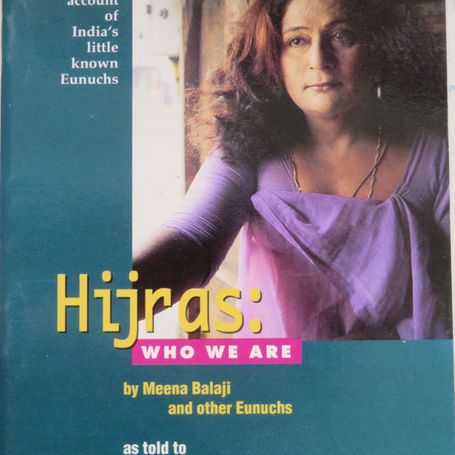
In Mumbai, in 1997, an interfaith Indian group and Ruth produced this booklet about a community of transgendered beggars known as Hijras. It is now available through Amazon.
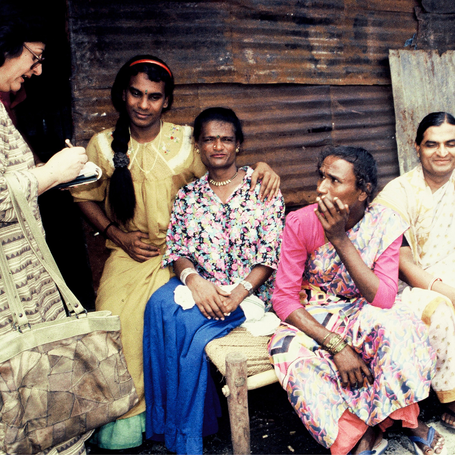
Kamal Dhalla (left), a Parsee, collaborated on the writing. Ruth took pictures at the temple of their goddess, in their homes and on the street.
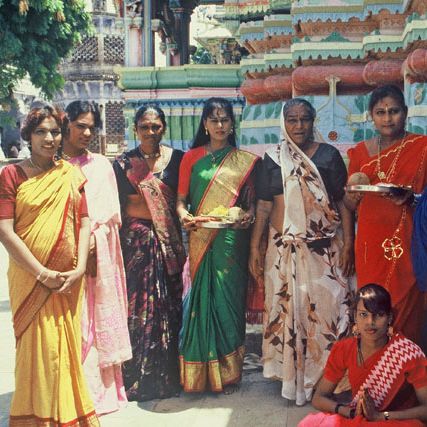
Traveling with Hijras on their pilgrimage to worship their goddess Bahuchara Mata in Gujarat was a privilege for her.
The message that Hijras were people with a religion and culture to be respected reached several million newspaper and magazine readers and helped Hijras feel human. Because it was challenging, this project was one of Ruth's most satisfying. You can read more details in her memoir.
Other Stories
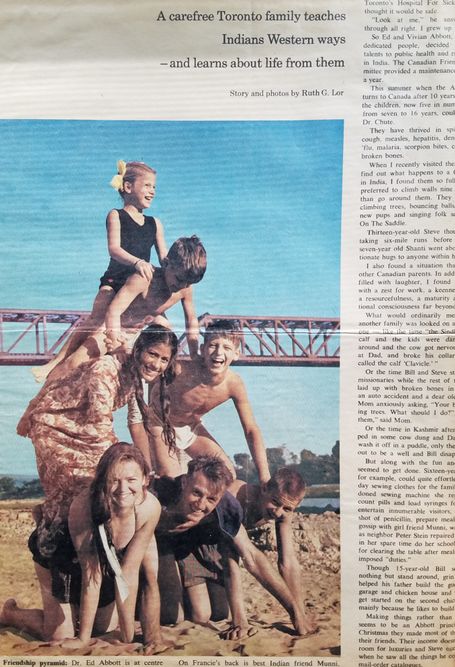
A carefree Toronto family teaches Indians Western way – and learns about life from them. Weekend Magazine. 1965.
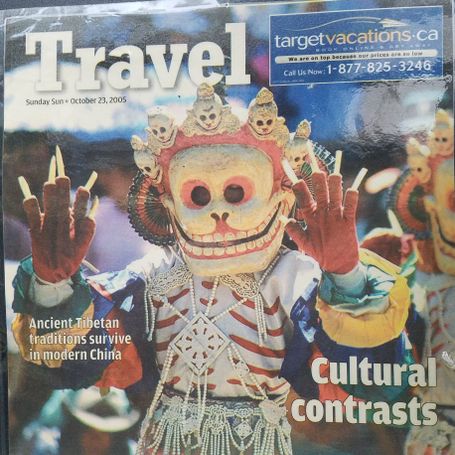
Ancient Tibetan traditions survive in modern China. Sunday Sun. Toronto. 2005.
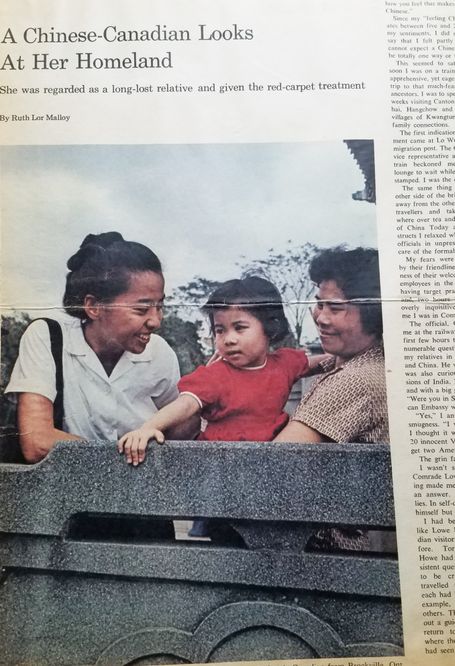
A Chinese-Canadian Looks At Her Homeland. Weekend. 1966.
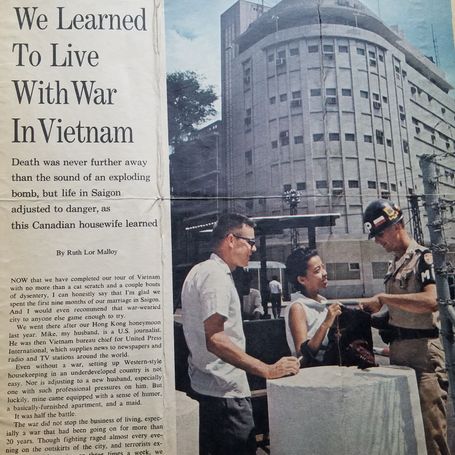
We Learned to Live with War in Vietnam. Weekend. Photo by Koichi Sawada. 1966.
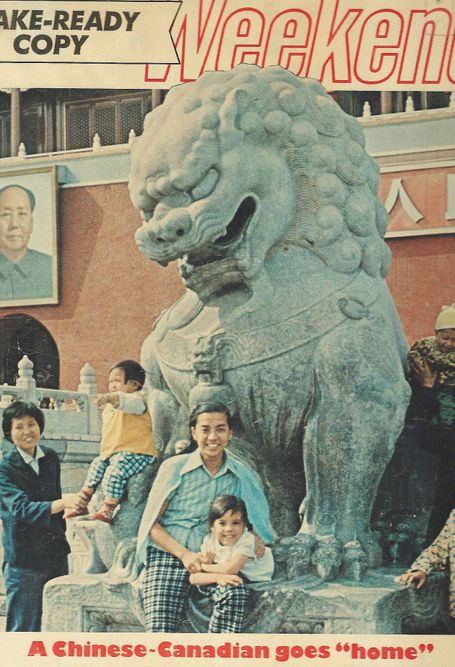
A Chinese-Canadian goes "home". 1973.
Photographer:
Ruth took pictures everywhere to illustrate her stories and to remind herself of everything she experienced. She especially liked photos of people who taught her something new or encouraged her attempts to be useful.
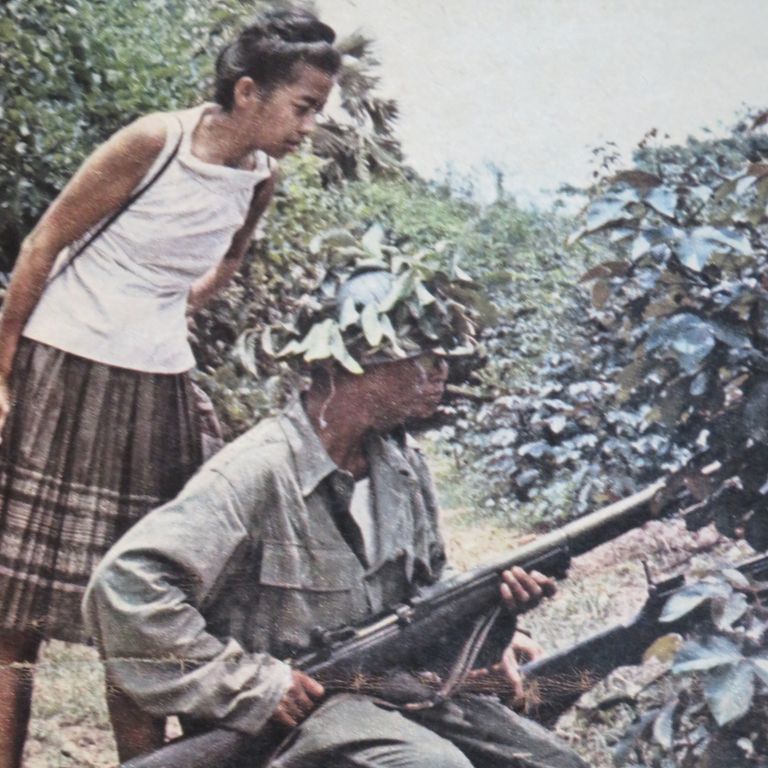
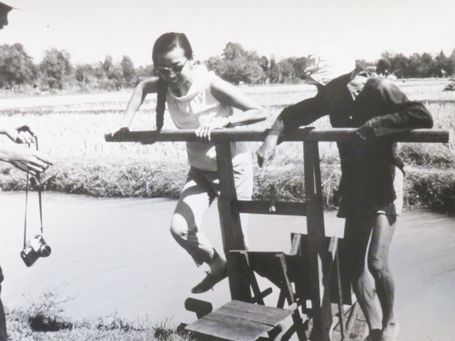
Experiencing irrigation the traditional Asian way for a magazine story.
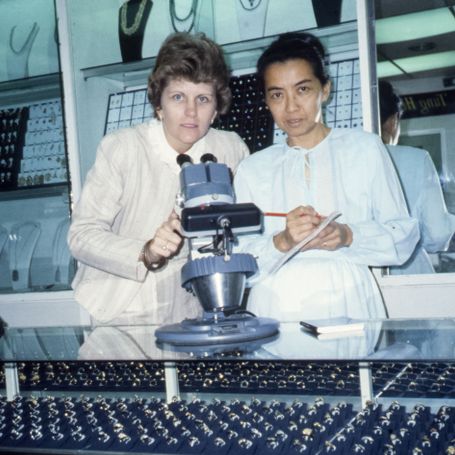
Ruth learned about gems for books with co-author Joan Ahrens. Hong Kong. 1982.
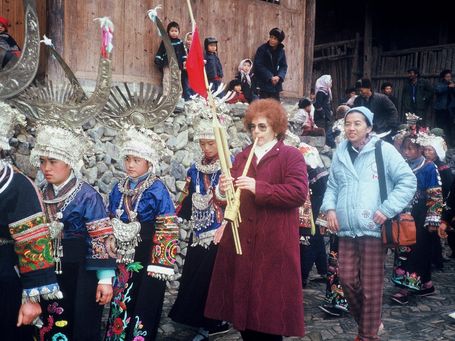
Friend Romaine Jones and Ruth with Hmong dancers in Guizhou, China.
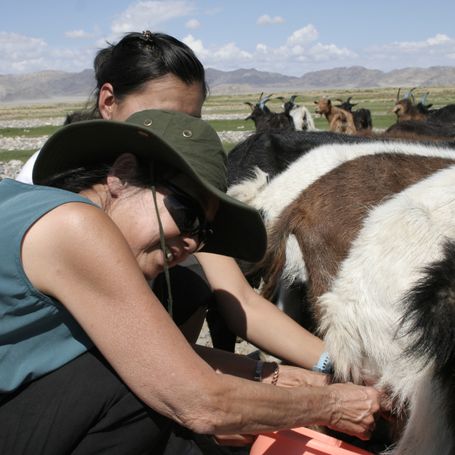
A hands-on lesson on milking a mare. Mongolia.
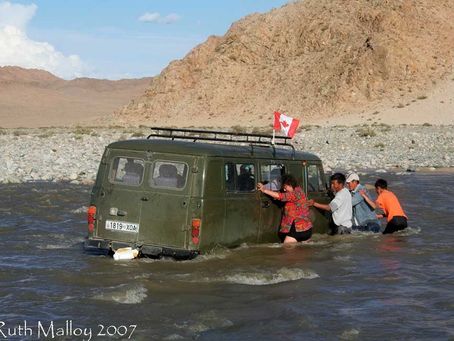
Frequent fellow traveler and especially helpful friend Francisca de Zwager and passersby helped rescue their van. Mongolia. 2007.
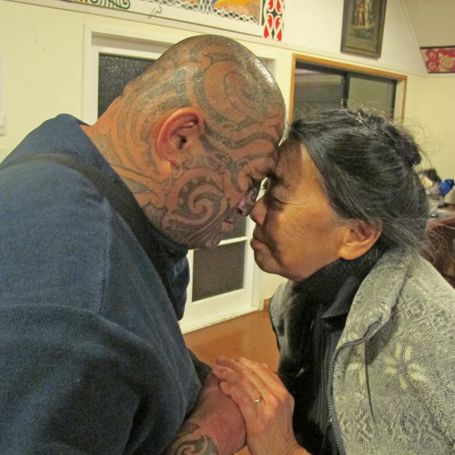
Enjoying a new type of greeting. Maori style. New Zealand.
Remembering some of the many problems that Ruth photographed keeps her motivated to help wherever possible. Over the years, her camera caught many of the things that still need fixing.
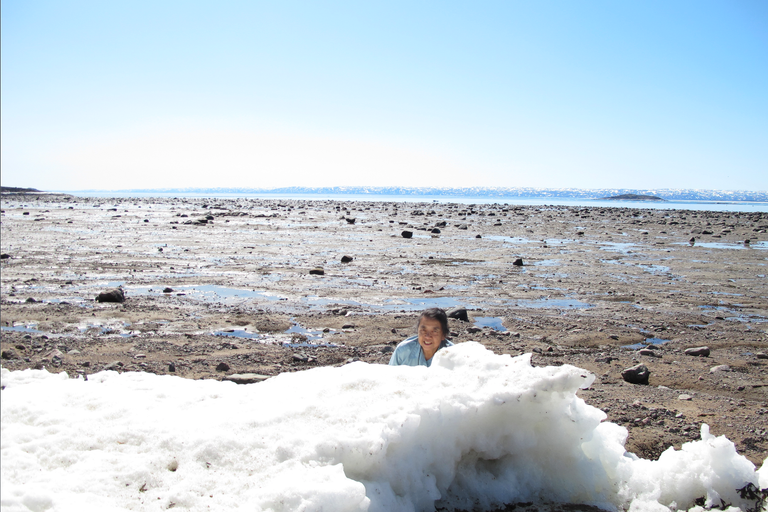
Arctic sea ice has been melting faster than expected. Low tide in Iqaluit here in July 2011 now has even less summer ice than during Ruth's visit. A world threat.
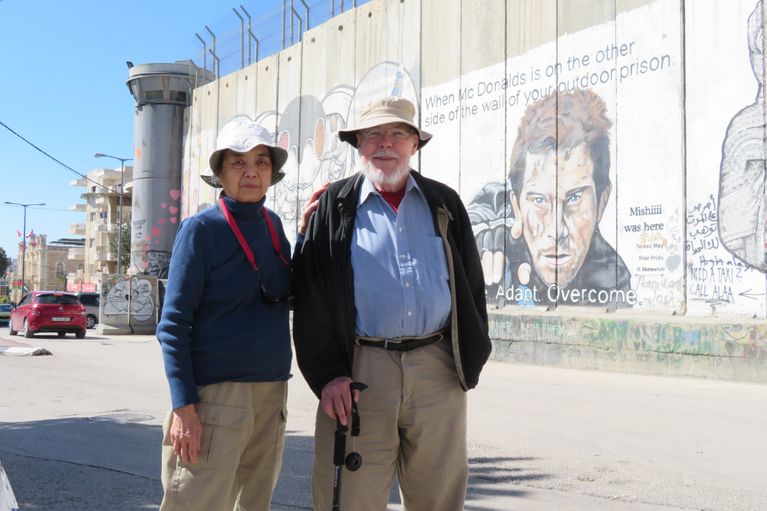
Real and psychological walls that keep people from working together and enjoying each other need to be dismantled. Israel. 2018.
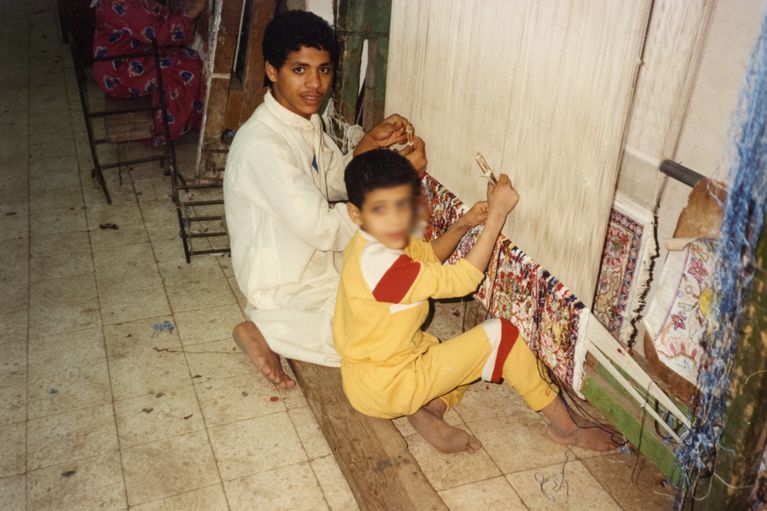
Child labor. Some countries now have laws forbidding the hiring of children under 14, but these rules might not be enforced. Child soldiers still exist today.
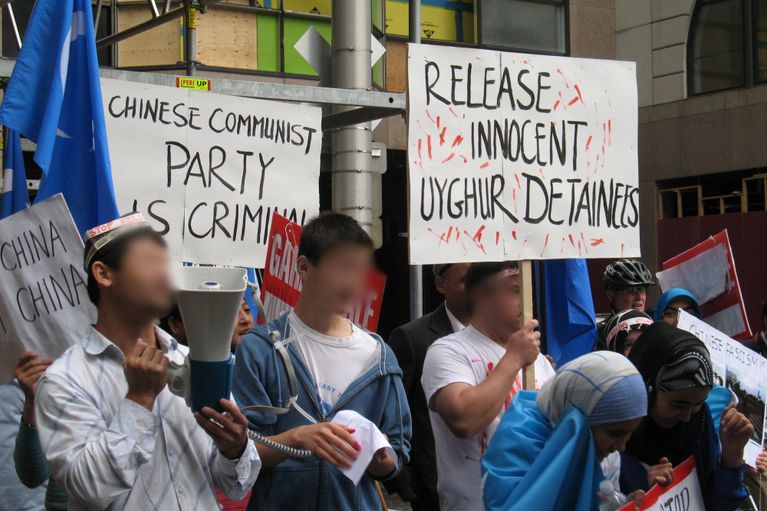
Cultural genocide and the imprisonment of Uighurs in China need to stop. Ruth found this reminder in a Toronto suburb. 2009.
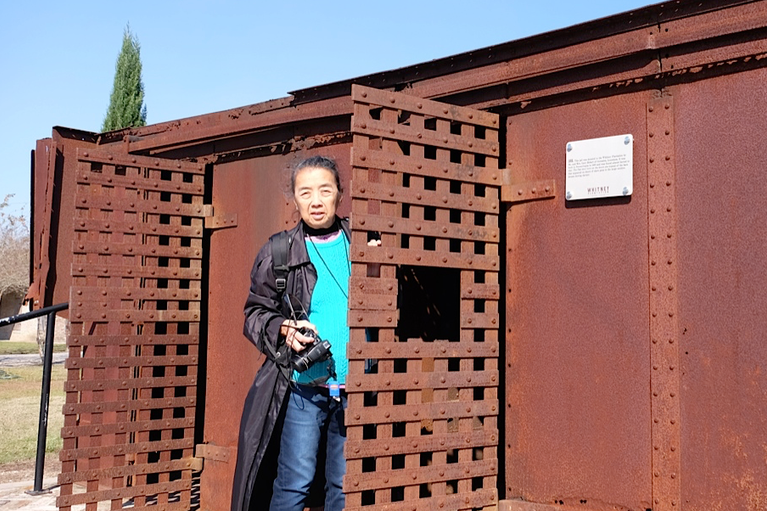
A pre-Civil War slave prison on display in a Louisiana plantation reminded Ruth of the roots of Black discrimination.
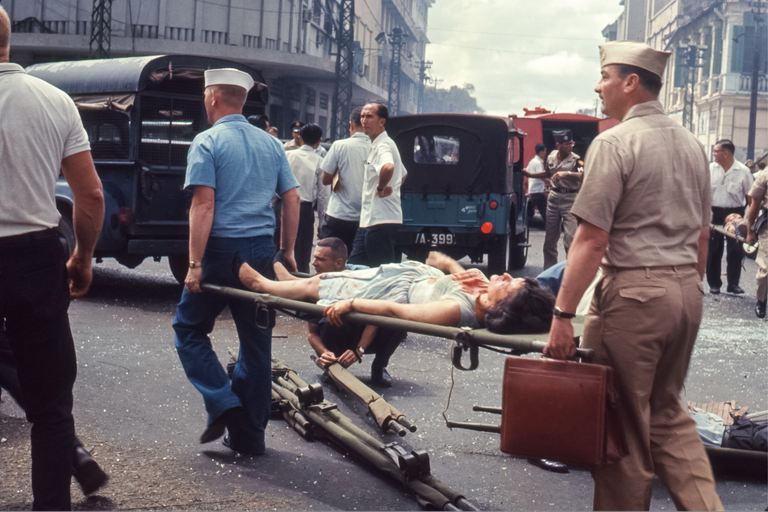
More peaceful ways to resolve conflicts must be developed. The U.S. Embassy bombing in Saigon was a Viet Cong response to U.S. bombs on Hanoi. 1965.
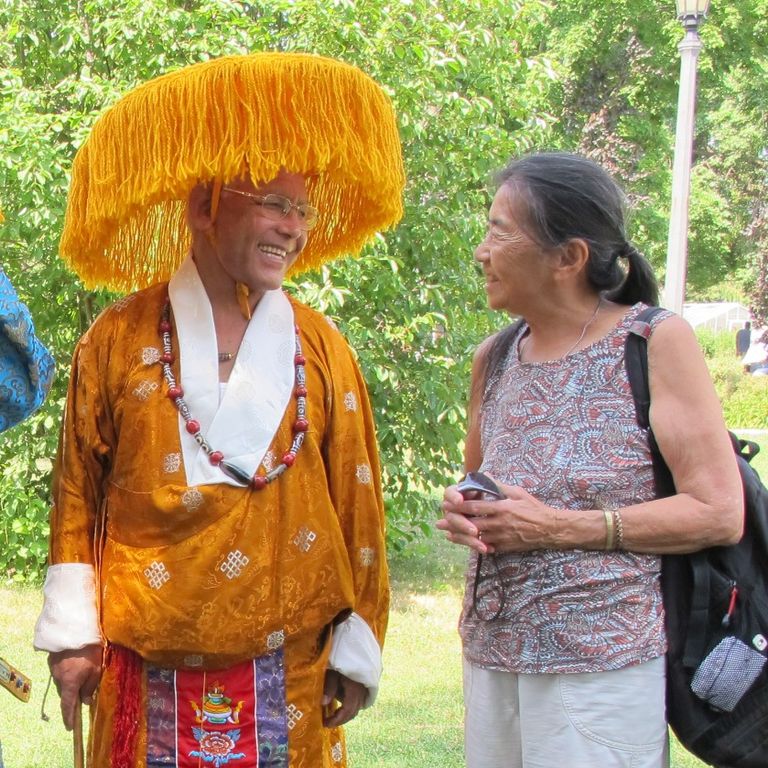
BLOGGER:
From 2010 to 2020 Ruth published an online blog promoting culturally-diverse events in Toronto, her multicultural city. By taking part she hoped that people of different groups would appreciate the customs of their neighbors, befriend immigrants and work together on common problems like global warming, gun violence, racism and mental health.
Ruth took thousands of pictures of lively, colorful events and decided that the customs were based on the same human instincts. Unfortunately, when ensconced in one’s own culture or even one’s political party, many people didn’t seem to care about the needs of others.
Fortunately she is not the only person concerned about these solitudes. Ruth feels that today even more than before, that our involvement in the world has to keep widening. We have to cooperate with each other so we can solve threats that affect us all. The future of our planet is in grave danger otherwise.
Ruth took these photos in Toronto before Covid-19 stopped all such events in 2020. Her full collection is saved in the archives of the Multicultural History Society of Ontario and York University.
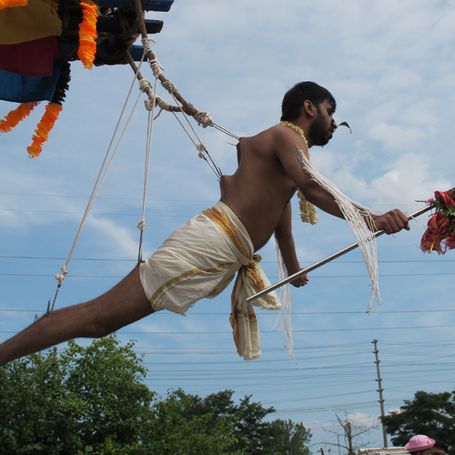
A penitent hangs for an hour during a festival at an annual Hindu temple festival.
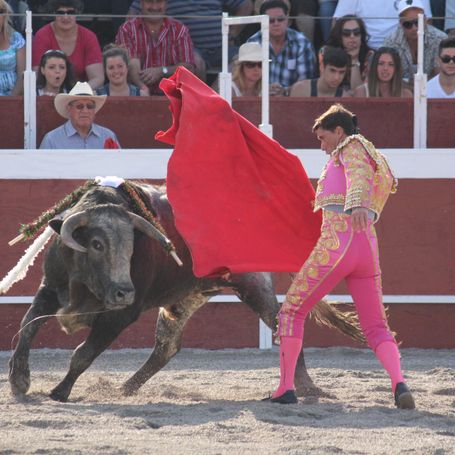
The last Portuguese bull fight took place in Toronto in 2013.
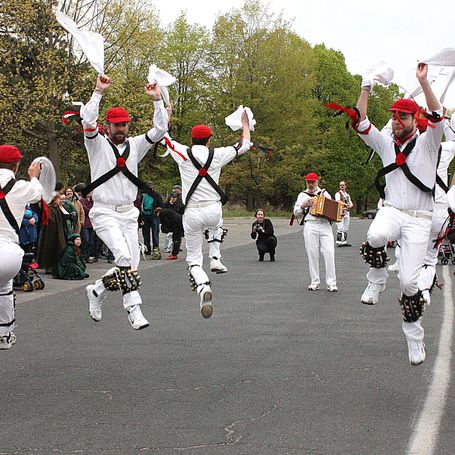
English-style Morris Dancers have fun every May Day.
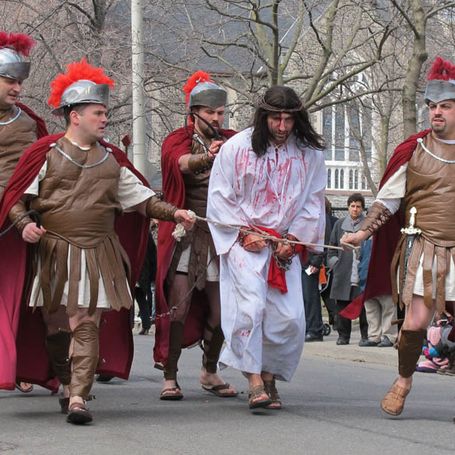
A lengthy Good Friday procession takes place annually in Little Italy.
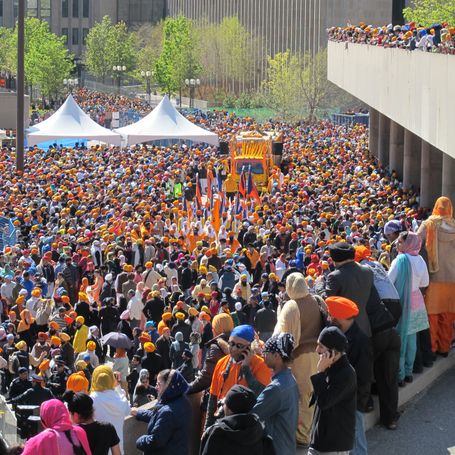
Khalsa Day at Toronto City Hall attracts thousands of Sikh celebrants.
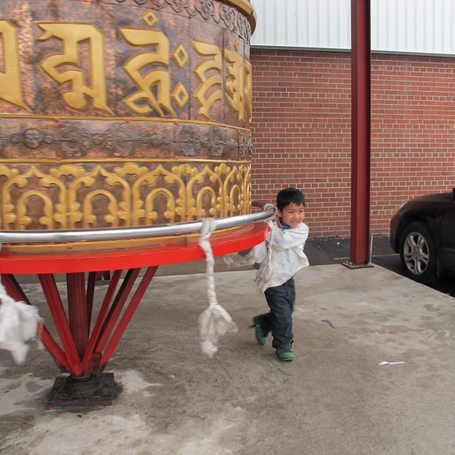
A giant prayer wheel is at the Tibetan Community Centre in Toronto.
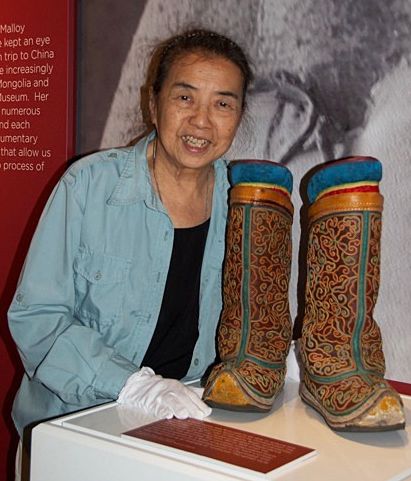
Boots of the last Mongolian queen are in the Bata Shoe Museum. Photo credit Toby Saltzman, Travelterrific.com.
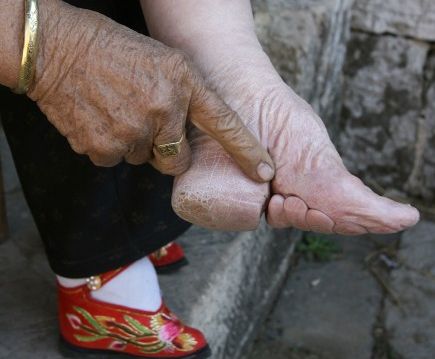
Woman's bound foot and shoe, an example of male supremacy in old China. 1980s.
Field Collector:
Ruth discovered another way to finance her travels. While traveling in China in the 1980s and later in Mongolia, Ruth bought a lot of hand-made footwear and embroidery from outdoor markets. She couldn't resist a bargain and discovered giving them to museums helped to pay some of her expenses. She collected tiny embroidered squares made by adolescent girls to prove to their future families that they could sew beautiful clothes for their children. Holding their art, Ruth felt a connection with exploited girls from the past who had no choice but to leave their birth families and bear the children of husbands they did not necessarily want.
From time to time, the Bata Shoe Museum in Toronto displays the shoes and boots Ruth collected. Among them were some of the tiny shoes finely-stitched by women whose feet were bound from childhood to keep them small. In the 1980s she met and photographed some of these women who were still alive then, the victims of ancient ideas of beauty and servitude. How she acquired the boots of the last "queen" or "empress" of Mongolia is a story in itself.
In Tibetan areas of China she visited isolated monasteries and bought the discarded, handmade boots of monks and nuns. Relatives had made the boots in the hopes of gaining merit for their generosity. The clerics preferred those made by machine. It was a win-win-win situation.
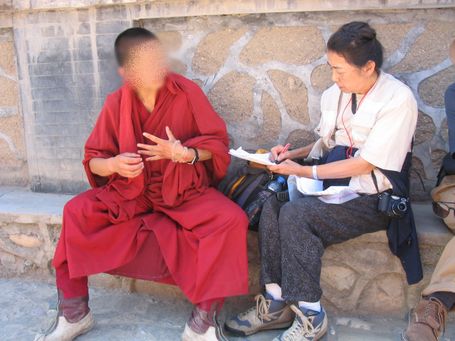
A Tibetan monk tells Ruth about his boots. Face obscured for his safety.
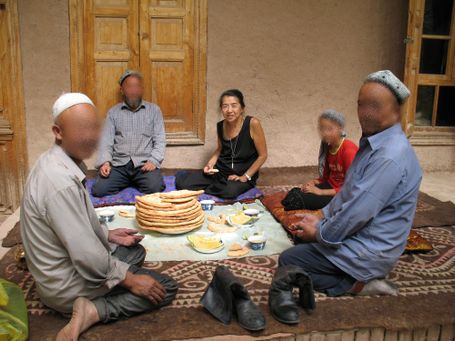
Ruth's search for footwear in Xinjiang, China came with Uighur hospitality. Image © Bata Shoe Museum. (Photo RLM)
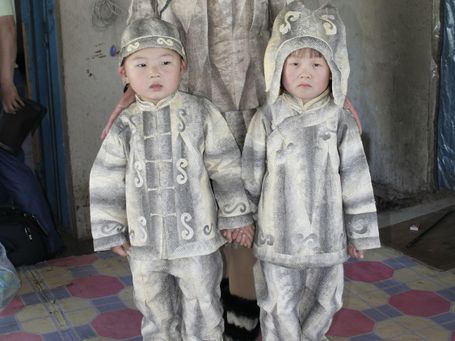
Ruth collected child-sized Hezhen salmon-skin suits for museums in Toronto and Edmonton.
Ruth also discovered that fish skin was the traditional fabric once worn by one of the many ethnic groups in China. She went to northeast China to meet a seamstress who knew how to make clothing with salmon. The Smithsonian Museum of Natural History in Washington displayed her photo of this woman with her two grandchildren. Two Canadian museums now own these child-sized suits. Such ingenuity helped pay for her travels. The Virtual Museum of Asian Canadian Cultural Heritage has Ruth's fish-skin story in: http://www.vmacch.ca/beta/fish-skin-clothing_collection.html.
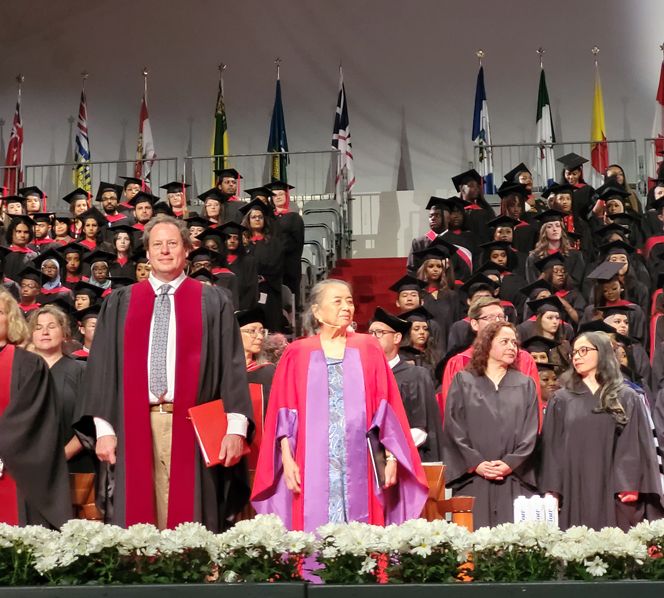
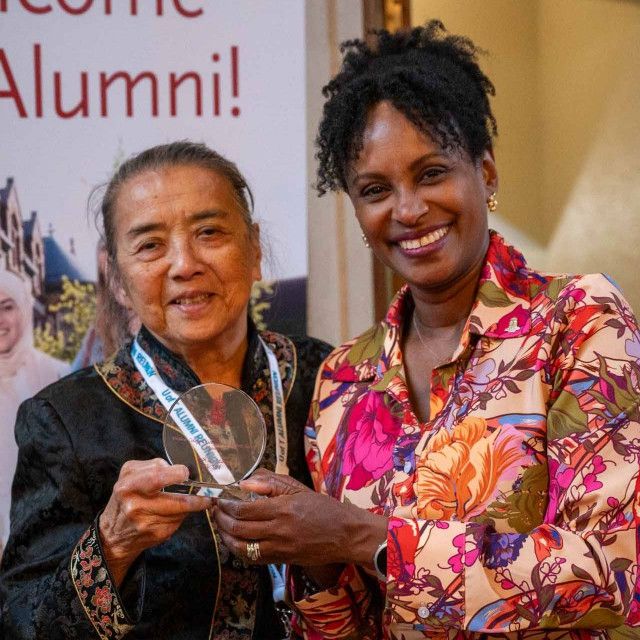
Ruth Lor Malloy LDD
In 2023 Toronto's York University bestowed an Honorary Doctorate of Laws degree to Ruth for her tireless efforts to combat discrimination and promote equality in Canada and beyond.
In 2024, Victoria University President Rhonda McEwen gave her the 2023 Distinguished Alumni Award in honour of her “lifetime vocation in the quest for national and global social justice.” Ruth graduated from Victoria College in 1954.
Family and Friends:
It was a lot of fun too. Ruth's family was a very important part of her life and she couldn't have achieved much of what she did without Mike, her best friend and husband. But it took her two years to decide to accept his marriage proposal.
Mike was an ideal father and even though he was an atheist, he supported her religious yearnings and her desire to be of service. He loved exploring, traveling and learning too. After he retired, he lived his dream of being an archeologist. She hopes other people are equally blessed in their chose of partner.
Together they enjoyed their huge extended families and many friends. They were blessed with three children, two grandchildren and two exceptionally-gifted daughters-in-law. Their life was full of laughter but like the lives of other people, it was not without its tragedies.
Brightening My Corner: a Memoir of Dreams Fulfilled was published in 2023 by Barclay Press.
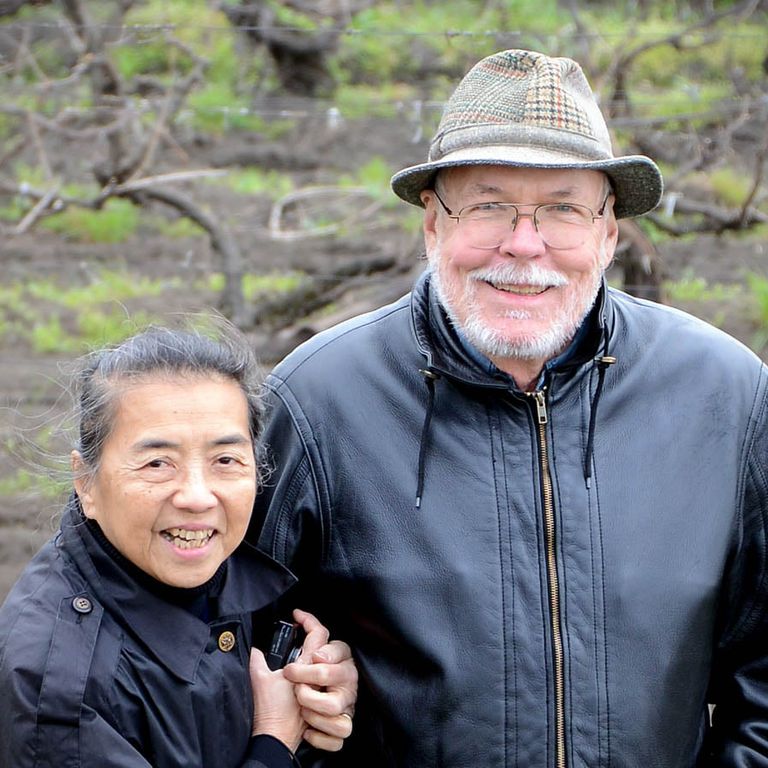
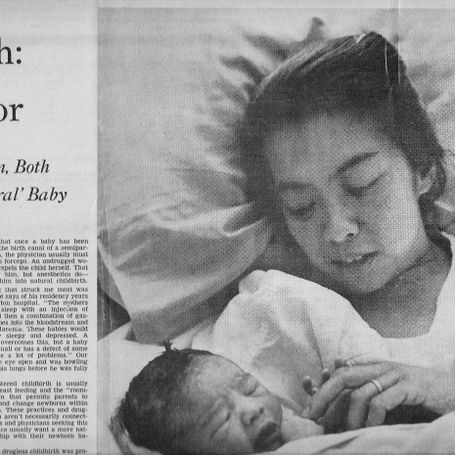
Mike's favorite picture. Son Terry arrived by natural childbirth with Mike as breathing coach, a new concept in 1971. Story was in the National Observer. Credit Michael T. Malloy.
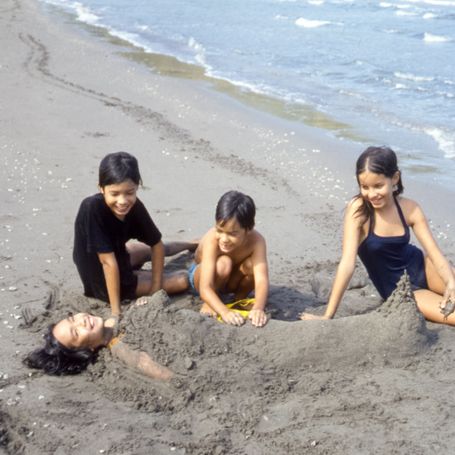
Yes, those are Ruth's gleeful children giving her a sand
bath.
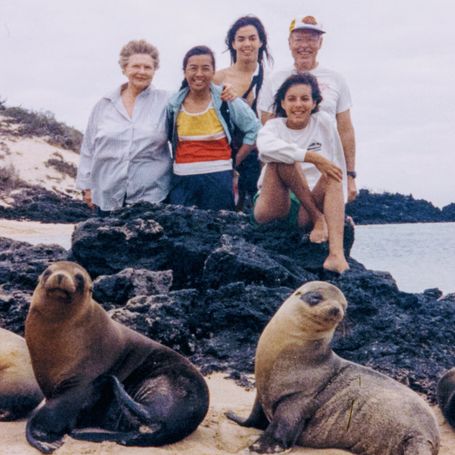
Galapagos vacation with Mike's mom and friends.
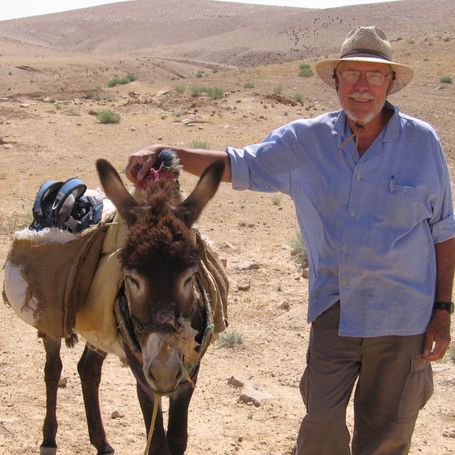
Mike as archeologist lived his dream in Jordan and Yemen. Photo credit Margaret Judd.
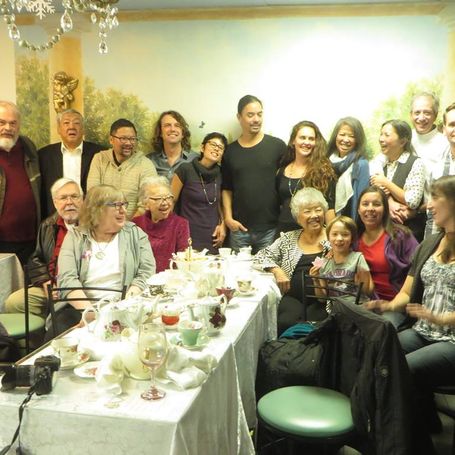
One of many extended family reunions. Toronto. 2017
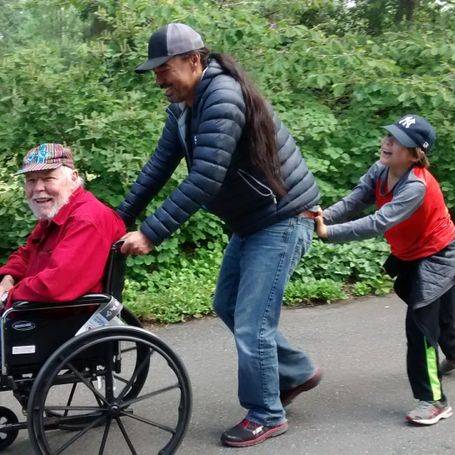
Younger generations continue family tradition of helping.
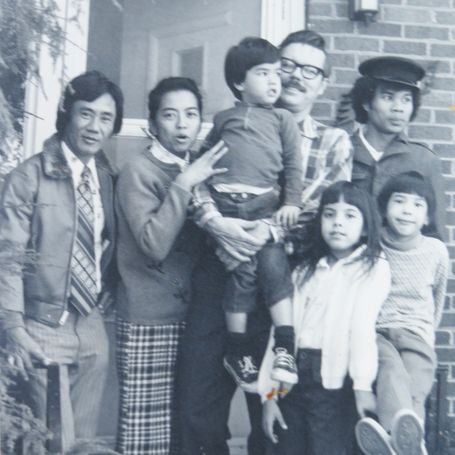
Two Vietnamese refugees joined the Malloy family for several months in the U.S. 1970s
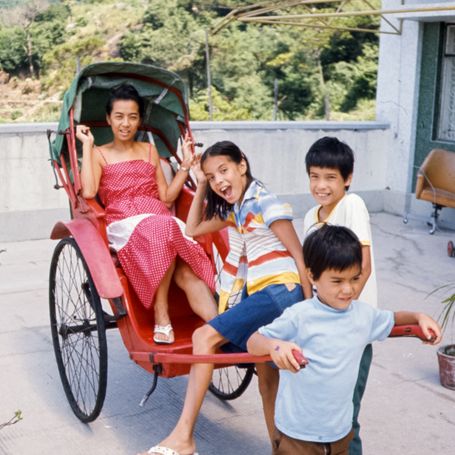
Hong Kong fun. Ruth took their children individually on her China research trips. 1980.
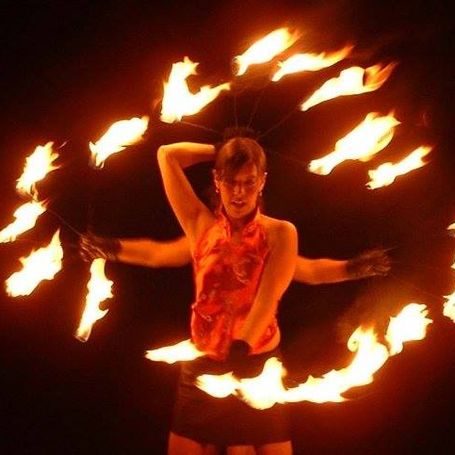
Daughter Linda as fire dancer. Photo credit Doug Reeves.
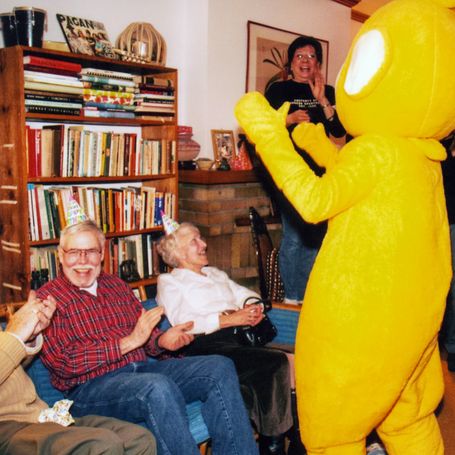
A teletubbie helped Mike celebrate his 75th Birthday. 2011.
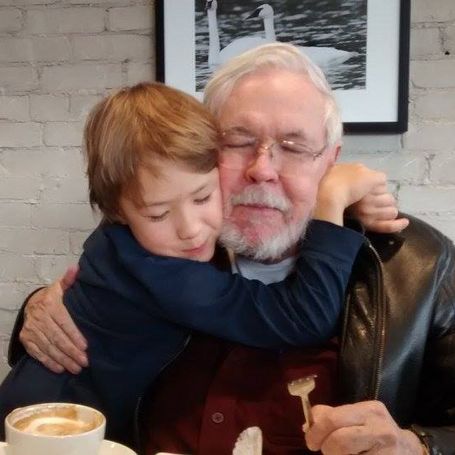
Mike with grandson Aaron.
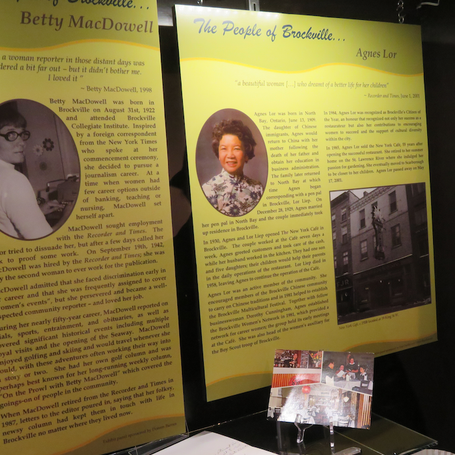
Ruth's mother was part of a Brockville Museum exhibit in 2021, an indication that their family hometown is much less racist now.
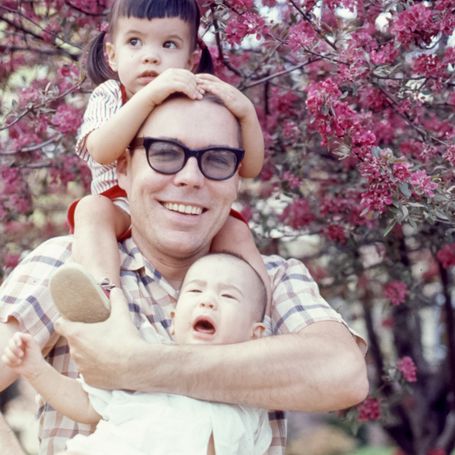
Mike was a cheerful father. He spent lots of time with his children and took them on his travels where possible. 1969.
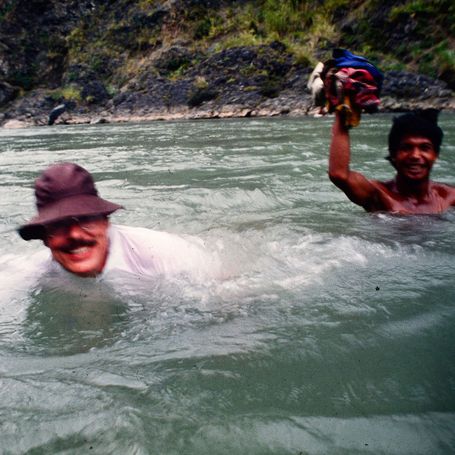
Mike on his way to research a story for the Asian Wall Street Journal. Philippines. 1970s. Photo courtesy Joe Cantrell.
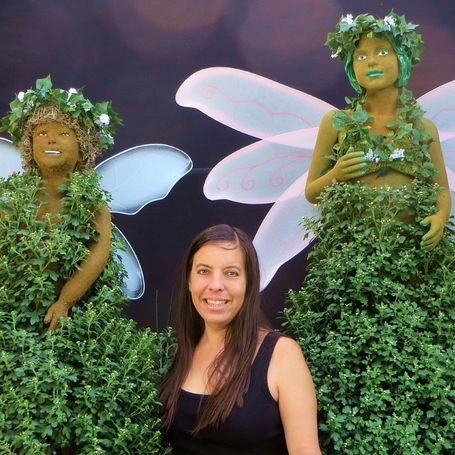
Linda as a professional gardener who can grow floral dresses on mannequins.
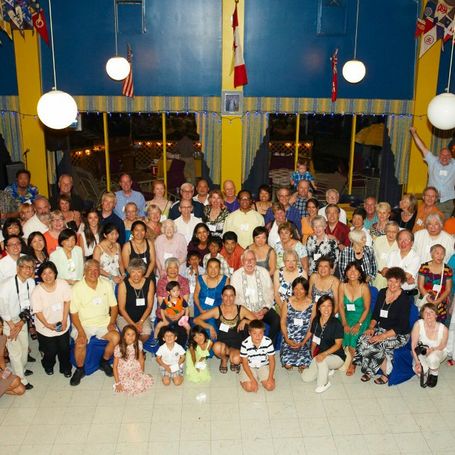
Ruth's 80th birthday party. Toronto.
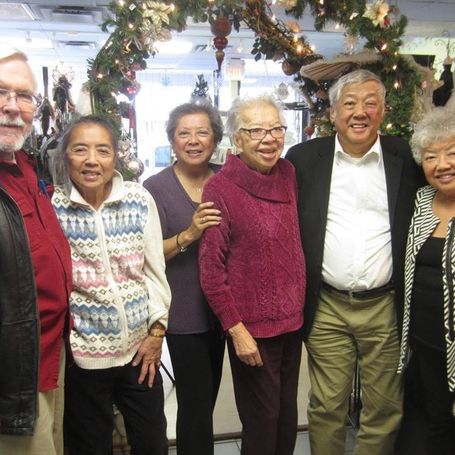
Reunion with Ruth's siblings. Left to right Mike, Ruth, Gloria, Alice, Joe, Valerie. 2017.
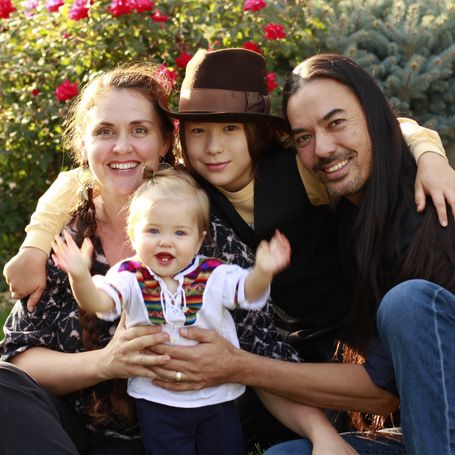
Their son Terry married the love of his life and gave Ruth two beautiful grandchildren.
Excerpts from Brightening My Corner
"... as a teenager, I also learned that when people were staring at me as though I was some weird animal in a zoo, I could do something about it. I stared back at them, a look of amused curiosity on my face. Within a minute, they would suddenly realise they were not invisible. They would look quickly away, and I knew I had some control over them. It was so funny...”
“I remember joining a group of school mates aggressively shouting 'Catholic! Catholic!' at some children who went to the Catholic school. I was in grade school and had no idea why we were doing this except that my friends were doing it. None of us, no one was free of prejudice..."
“One day, I naively complimented a close friend about the prominent tattoo on her arm. It was a pretty color. I was embarrassed at my lack of knowledge when she said the tattoo was not a decoration. The Nazis had marked all its Jewish prisoners with tattoos... I knew I had a lot to learn.“
"Perhaps we should have given some kind thoughts to people like the misguided Morley McKay too. Why did he feel such hatred towards Black people?...”
"... they were setting up our tents when a wild, agitated bull elephant started walking slowly and menacingly towards us, spreading his ears, shaking his head, and bellowing. Black liquid streaked down his cheek. As the monster came closer and closer, guide Leko kept quietly repeating, "Don’t move; don’t run.” Terry was shaking so much that he dropped his camera... we learned a couple lessons that day".
"India and Pakistan were almost at war with each other and I should have known better. I was on my way to India which could have used pictures of the strategically-located dam. In Lahore, where I was staying in a hotel with Quaker friends, a policeman came and confiscated all my films, including my pictures from the bus trip. They could have put me in jail as a spy, he said."
"As I was thinking about my options, a strange co-incidence happened, which I like to think wasn’t a co-incidence. Was this an act of God? I had been trying to get a visa to China with no success. One evening, as I was passing through the lobby of my apartment building in Ottawa, a friendly stranger approached. Although she lived there too, we had never met, and she asked if I was Chinese. During the conversation, I must have mentioned my desire to go to China. She was the secretary of the Canadian Minister of Agriculture who had just sold sixty million dollars worth of wheat and barley there. No other country wanted to deal with the Communist government. They were all afraid of annoying the United States..." A couple Chinese journalists were present that evening.
"Photographers have to record events. That’s what we do. However, should I have laid my camera aside and helped with the wounded? Should I have remembered Mike’s warning about a possible second bomb aimed at people there to help?"
"That evening at a hotel, Terry felt as though he was dying. Prickles of oxygen depletion moved from his fingers into his arms and towards his heart and lungs. He shouldn’t go any higher. I had to choose between taking him back to Lhasa myself or sending him back alone. If I went with him, there was no way to catch up with the group later because there were no buses or taxis where we were going. It was one of my hardest decisions. What was God’s will? "
"A special trip was with a San Francisco couple who were taking their eight-year-old China-born daughter back to China for the first time to see the orphanage where they had adopted her."
"I also started attending Al-Anon meetings. It’s the organization related to Alcoholics Anonymous that supports families and friends of alcoholics. Al-Anon was concerned with drug abusers too. It reminded me to 'Let go and let God.' Meetings ended with a prayer: 'God grant me the serenity to accept the things I cannot change, courage to change the things I can, and the wisdom to know the difference.'"
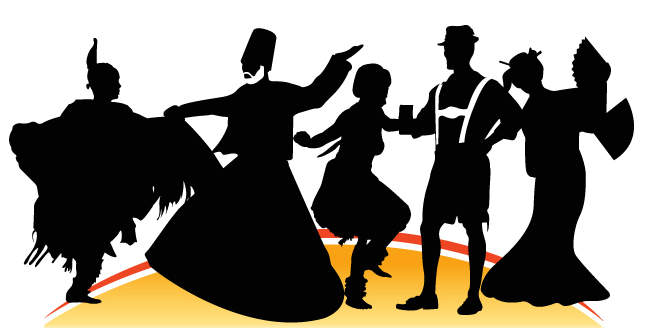
CONTACT
If you have any questions or comments please contact:
E-mail: Ruth@ruthlormalloy.com
Facebook: www.facebook.com/RuthLorMalloy
We need your consent to load the translations
We use a third-party service to translate the website content that may collect data about your activity. Please review the details in the privacy policy and accept the service to view the translations.
